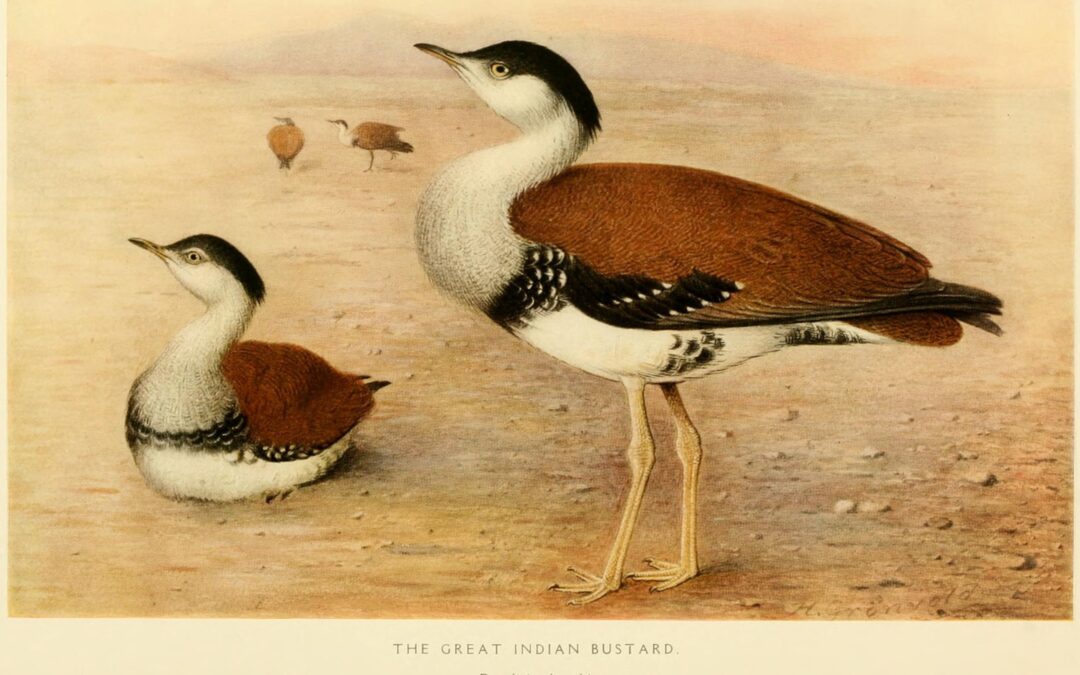Our first episode was about the Great Indian Bustard. The logo of the Bird Podcast is the Great Indian Bustard or GIB as it is called. Salim Ali wanted this bird to be India’s national bird for three reasons: it is indigenous to India, it is a large and charismatic bird, and it deserves protection because its numbers were dwindling, even in the 1950s when Ali made his plea. Instead the peacock won out. Then, as now, the fate of the bustard hangs in balance. Will we save the bustard?
The biggest problem for bustards: the powerlines that criss-cross the desert landscape. Locals hate them because they are ugly. Bustards cannot see them because their frontal vision is poor. In October 2022, yet another bustard was killed because it flew into a power transmission line, prompting wildlife organizations such as the Bombay Natural History Society or BNHS to once again petition the government to lay these lines underground.
The bustard is among the heaviest flying birds in the world. In 1969, there were reportedly 1260 bustards in India, mostly in Rajasthan, Gujarat and Maharashtra.
In 2017, when we interviewed forest officials in Desert National Park, there were 150 birds. Today too, there are 150 birds. So while the numbers haven’t risen, they haven’t dropped either. There are 128 in Rajasthan’s desert regions, less than 10 in Gujarat and Maharashtra, and 16 chicks being raised in Sudashri incubation centre in Rajasthan.
Below is a thoughtful poignant excerpt from here.
“The sheer size of the bird was paralyzing; faintly evoking a long-suppressed mammalian fear of dinosaurs. But the flight itself was majestic, with not a hint of the labour and desperation one would expect and see in the flight of a large bird, like in that of the Indian peafowl, which is infinitely more graceful standing. Every wing beat it made, unfurled the taut understanding of time that the mind relies on to keep track of reality, distorting what must have lasted a few seconds into a seemingly endless loop, progressively wrapping my psyche with a sense of wonderment.
Extinction is the death of a species. It’s a permanent hole in the ecological tapestry in which we are interwoven. It is a great loss. Several species are already extinct such as the Malabar Civet, Pink headed duck, and Himalayan quail.” The question is: are these bustards flying into extinction?
And from the New Indian Express. “The clear threat to the Great Indian Bustard is from humans, who have hunted the birds out of their natural habitat of grasslands in 12 states. The grasslands are under cultivation, and renewable energy projects are being set up, especially in Gujarat and the Thar Desert. Solar parks and wind turbines are shrinking the bustard’s habitat, and crisscrossing power lines are a hazard for the heavy, low-flying birds that lack frontal vision, resulting in collision and electrocution. There are natural predators, too—eggs are often stolen from nests by foxes, mongooses, monitor lizards and vultures. At the same time, the chicks are preyed on by felines and jackals, making them a vulnerable species.”
“Fossil records indicate that bustards originated in Africa, from where they diverged to occupy much of the Old World. No bustard species are found in the New World. There are 25 species of bustards, but many subspecies are currently being reclassified as separate species, increasing this figure.
Bustards have long been associated with humans and have been represented in cave drawings, rock engravings, and church mosaics. The word bustard comes from the Latin avis (“bird”) and a lost Spanish word, tarda, which is related to the English word “tread” and signifies “walking.”
A typical bustard has a short bill and a long, slender neck and is stout bodied, short tailed, and supported on long legs with only three toes. Unlike most bird species, bustards have hexagonal, not transverse- shaped, scales on their legs and no preen glands with which to oil their feathers. They compensate for their missing preen gland by producing powder down, and they maintain their feathers by grooming them with their bill, transferring the powder to all surfaces.”
The Rajasthan government has launched a project to save the bustard. Bird Podcast sincerely hopes that this will be successful.



Lets wake up before it’s to late for the GIB